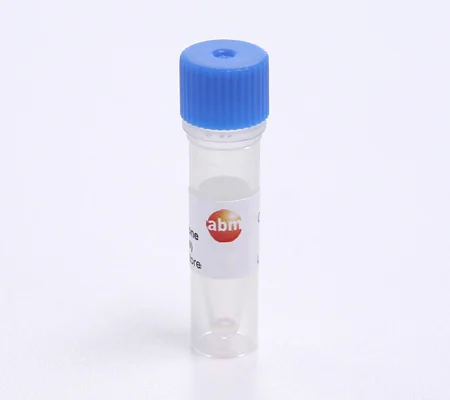
Prigrow I Medium

| CAT.NO | UNIT |
|---|---|
| TM001 | 500ml |
| Description | abm’s PriGrow Media Series for mammalian cell culture is composed of high-quality, specific formulations for the optimal growth of different types of primary cells.
PriGrow media is offered as a basal, serum and antibiotic-free formula to provide the end user with the flexibility of further supplement and serum addition if required. Each lot has been fully tested and optimized for the ability to support the growth of the intended primary cells, in addition to being QC tested for sterility, pH, osmolality and endotoxin levels. Special media modification is available as a Custom Media Service, please contact a technical representative at technical@abmgood.com for more details. |
|---|---|
| SKU | TM001 |
| Caution | For research use only and is not intended for therapeutic or diagnostic applications. abm products are intended for laboratory research purposes only, unless noted otherwise. They are not intended for use in humans. abm makes no warranties or representations as to the accuracy of the information on this site. Citations from literature and provided for informational purposes only. abm does not warrant that such information has been shown to be accurate. |
| Endotoxin Level | ≤ 1EU/ml |
| Osmolarity | 270-310 mOsm/kgH2O |
| pH | 7.15-7.25 |
| Sterility | Pass |
| Storage Condition | Store at 2-8°C. |
| Unit quantity | 500ml |
Which is the buffer hepes, bicarbonate and any detailed information you can share with us about the formulation of the Prigrow media. Which is the difference between different types of Prigrow?
The Prigrow Series are basal media formulated to suit the needs of our specialized cell lines. The proportion of bicarbonate and HEPES buffers, nutrients, additives and basal supplements in each Prigrow is different, depending on the needs of the cell lines the media was optimized for.
What is the difference between PriGrow I, II, III or IV?
Each medium is optimized with our proprietary formulation to support the proliferation and growth for different cell types.
Do we need anti-biotics in the media?
ABM's PriGrow consists of basal medium only. In order to make it into complete media, usually one needs to add 10% FBS as well as antibiotics, if desired. To answer the question, yes you will need to add your own antibiotics or antifungal solution.
What is the color of the PriGrow media?
All of ABM's PriGrow media are red, as they contain Phenol Red Indicator.
For the PriGrow Series, are they serum free media?
Yes, PriGrow Series are provided as serum free media. The end user has to add FBS to make the media complete.
Is a free sample for the media available?
Unfortunately we do not offer free samples for this product.
I would like to purchase a compatable media to PriGrow, could you please recommend one?
We have optimized our media composition to provide the best growth conditions for the cell types it supports. We do not carry out testing of other products to be able to suggest alternatives that can perform to the same standards.
Can this media be frozen and thawed?
Freezing the media may compromise the quality of the product, therefore we advise only to store at 2-8°C
Does Prigrow I contain glucose?
Yes, TM001 contains 0.86 g/L glucose
Does Prigrow I media contain any ammonium trioxovandate?
Yes, Prigrow I will contain ammonium trioxovandate (<0.01%).
a:{color:#b7472a;}
- Gong, B et al. "Exchange protein directly activated by cAMP plays a critical role in bacterial invasion during fatal rickettsioses." Proc Natl Acad Sci U S A. 110(48):19615-20 (2013). DOI: 10.1073/pnas.1314400110. PubMed: 24218580.
- Gong, B et al. "Compartmentalized, functional role of angiogenin during spotted fever group rickettsia-induced endothelial barrier dysfunction: evidence of possible mediation by host tRNA-derived small noncoding RNAs" BMC Infect Dis. 13:285 (2013). DOI: 10.1186/1471-2334-13-285. PubMed: 23800282.
- Gong, B et al. "Rickettsiae induce microvascular hyperpermeability via phosphorylation of VE-cadherins: evidence from atomic force microscopy and biochemical studies" PLoS Negl Trop Dis 6(6):e1699 (2012). DOI: 10.1371/journal.pntd.0001699. PubMed: 22720111.
- Gong , B. et al. "METHODS OF TREATING RICKETTSIA USING EXCHANGE PROTEINS DIRECTLY ACTIVATED BY CAMP (EPACS) INHIBITORS" Patent : (2014). PubMed: US20140348853.
- Hansen, K et al. "Feasibility Investigation of Cellulose Polymers for Mucoadhesive Nasal Drug Delivery Applications" Molecular Pharmaceutics 8:2732-2741 (2015). PubMed: 26097994. Application: cell culture.
- Prince, J et al. "MicroRNA-9 inhibits hyperglycemia-induced pyroptosis in human ventricular cardiomyocytes by targeting ELAVL1" Biochemical and biophysical research communications 4:423-429 (2016). DOI: doi: 10.1016/j.bbrc.2016.02.065. Application: Culture.
- Lai, IL et al. "Targeting the Warburg effect with a novel glucose transporter inhibitor to overcome gemcitabine resistance in pancreatic cancer cells" Carcinogenesis 10:2203-2213 (2014). DOI: doi: 10.1093/carcin/bgu124. PubMed: 24879635 . Application: Culture.
- Jeyabal, P et al. "MicroRNA-9 inhibits hyperglycemia-induced pyroptosis in human ventricular cardiomyocytes by targeting ELAVL1" Biochem. Biophys. Res. Commun. 4:423-429 (2016). DOI: 10.1016/j.bbrc.2016.02.065. PubMed: 26898797. Application: Culture.
- Kono, K., Sawada, R., Kuroda, T., Yasuda, S., Matsuyama, S., Matsuyama, A., ... & Sato, Y. "Development of selective cytotoxic viral vectors for concentration of undifferentiated cells in cardiomyocytes derived from human induced pluripotent stem cells" Scientific reports 9(1):3630 (2019).
- Li, Y., Hong, J., Jung, B.-K., Oh, E., & Yun, C.-O. "Oncolytic Ad co-expressing decorin and Wnt decoy receptor overcomes chemoresistance of desmoplastic tumor through degradation of ECM and inhibition of EMT" Cancer Letters 459:15–29 (2019). DOI: 10.1016/j.canlet.2019.05.033.
- Liu, Q., Wang, X., Liu, X., Kumar, S., Gochman, G., Ji, Y., ... & Jiang, J. "Use of Polymeric Nanoparticle Platform Targeting the Liver To Induce Treg-Mediated Antigen-Specific Immune Tolerance in a Pulmonary Allergen Sensitization Model" ACS nano 13(4):4778-4794 (2019).
- Liu, Q., Zhao, Y., Xing, H., Li, L., Li, R., Dai, J., … Fang, S. "The role of R-spondin 1 through activating Wnt/β-catenin in the growth, survival and migration of ovarian cancer cells" Gene 689:124–130 (2019). DOI: 10.1016/j.gene.2018.11.098.
- Quintela, M., Sieglaff, D. H., Gazze, A. S., Zhang, A., Gonzalez, D., Francis, L., … Conlan, R. S. "HBO1 directs histone H4 specific acetylation, potentiating mechano-transduction pathways and membrane elasticity in ovarian cancer cells" Nanomedicine: Nanotechnology Biology and Medicine:17 (2019). DOI: 10.1016/j.nano.2019.01.017.


